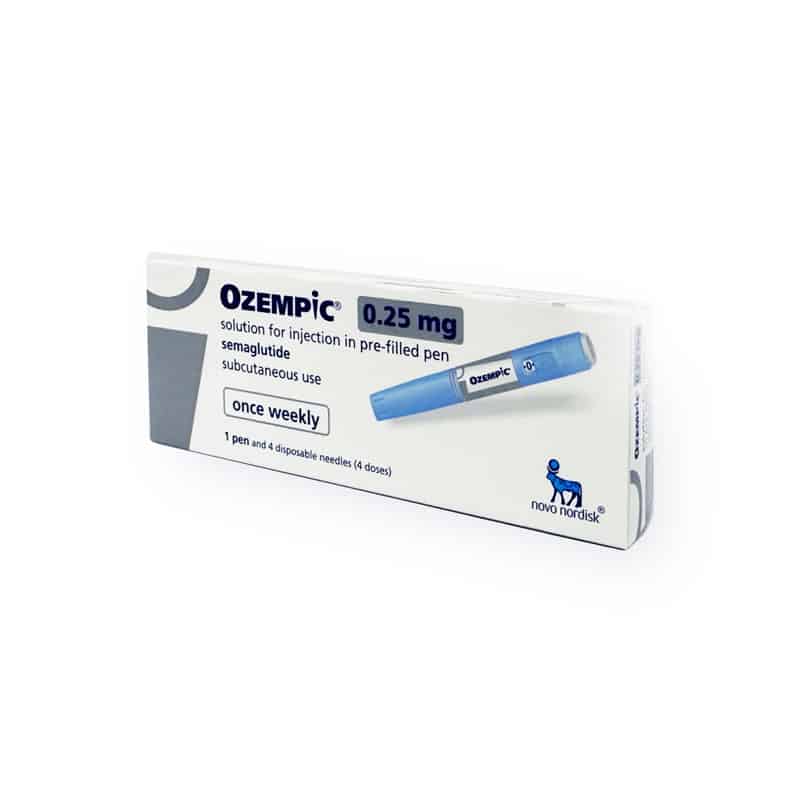OZEMPIC® Indications for Use
OZEMPIC® contains semaglutide, which belongs to a class of medications known as GLP-1 receptor agonists. It is primarily used for the management of type 2 diabetes mellitus in adults. OZEMPIC® works by stimulating the production of insulin in response to high blood sugar levels, reducing glucagon release, and slowing gastric emptying.
Key Indications:
- Type 2 diabetes mellitus: To improve glycemic control in adults.
- Can be used as monotherapy or combined with other diabetes medications like metformin, thiazolidinediones, sulfonylureas, or insulin.
Not suitable for:
- Type 1 diabetes or diabetic ketoacidosis (conditions where insulin production is insufficient or absent).
OZEMPIC® Dosage Information
OZEMPIC® is supplied as a pre-filled pen containing semaglutide. The pen can deliver doses of 0.25 mg or 0.5 mg of semaglutide. The usual regimen starts with 0.25 mg once weekly for four weeks, then the dose is increased to 0.5 mg once weekly. If further glycemic control is needed, the dose can be increased to 1 mg once weekly after medical consultation.
Dosage Summary:
- Starting dose: 0.25 mg once weekly for the first four weeks.
- Maintenance dose: 0.5 mg once weekly.
- Maximum dose: 1 mg once weekly (if necessary and prescribed by a doctor).
OZEMPIC® should be injected subcutaneously in the abdomen, thigh, or upper arm. The injection is administered once a week, at any time of the day, with or without meals.
OZEMPIC® Side Effects and Precautions
Patients using OZEMPIC® may experience a variety of side effects, ranging from mild to severe. The most common side effects are related to the gastrointestinal system, but there are also risks associated with more serious conditions like pancreatitis or hypoglycemia.
Common Side Effects:
- Nausea, diarrhea, and vomiting: These gastrointestinal symptoms tend to lessen over time as the body adjusts to the medication.
- Decreased appetite and indigestion.
- Injection site reactions: Minor redness, swelling, or discomfort at the injection site.
Serious Side Effects:
- Acute pancreatitis: Signs include severe and persistent abdominal pain, often radiating to the back.
- Hypoglycemia (low blood sugar): This risk is higher if OZEMPIC® is used alongside other diabetes medications like sulfonylureas or insulin.
- Diabetic retinopathy: Worsening of existing diabetic eye conditions, so regular eye checks are recommended.
- Allergic reactions: This may include swelling of the face, rash, itching, or difficulty breathing.
Precautions:
- Pregnancy: OZEMPIC® should not be used during pregnancy and should be discontinued at least two months before a planned pregnancy due to the risk of harm to the fetus.
- Breastfeeding: It is unknown whether semaglutide passes into breast milk, so it should not be used while breastfeeding.
- Gallstones and gallbladder disease: OZEMPIC® may exacerbate these conditions.
OZEMPIC® Clinical Studies or Real-World Outcomes
Clinical trials have shown that OZEMPIC® significantly improves glycemic control in patients with type 2 diabetes. In addition to its effects on blood glucose, it has been observed to support weight loss in patients, making it particularly beneficial for overweight individuals with diabetes.
Efficacy Results:
- Studies demonstrated that patients taking OZEMPIC® experienced an average reduction in HbA1c levels by up to 1.5% after 24-30 weeks of treatment.
- OZEMPIC® has also shown significant weight reduction, with patients losing up to 5-7 kg over the course of treatment.
Patient Satisfaction:
- High patient satisfaction was reported due to the once-weekly dosing and ease of administration.
- Improvements in both glycemic control and weight contributed to positive real-world outcomes.
OZEMPIC® Drug Interactions
OZEMPIC® can interact with other medications, particularly those that affect blood sugar levels or the digestive system. Proper care should be taken when combining OZEMPIC® with other treatments.
Important Drug Interactions:
- Sulfonylureas (e.g., glimepiride, glibenclamide): Combining these with OZEMPIC® can increase the risk of hypoglycemia. Your doctor may need to adjust the dose of the sulfonylurea to avoid low blood sugar.
- Insulin: The dose of insulin may also need to be reduced to prevent hypoglycemia.
- Oral medications: Due to delayed gastric emptying, medications that are affected by the speed of absorption (e.g., oral contraceptives) should be closely monitored.
OZEMPIC® Aftercare Instructions
It is essential to follow proper aftercare guidelines to ensure the best therapeutic outcomes and minimize side effects.
Post-Injection Care:
- Rotate the injection site each week to avoid irritation and ensure proper absorption.
- Store unused pens in a refrigerator between 2°C and 8°C but avoid freezing. Once in use, pens can be kept at room temperature for up to 6 weeks.
- If a dose is missed and less than 5 days have passed, administer the dose as soon as remembered. If more than 5 days have passed, skip the missed dose and continue with the regular schedule.
What to Expect:
- Nausea and digestive discomfort are common but typically subside with continued use.
- Regular monitoring of blood sugar levels is necessary to prevent hypoglycemia, especially when using additional medications like insulin.
OZEMPIC® Follow-Up Treatments
OZEMPIC® is a long-term treatment for type 2 diabetes, and patients may need to adjust their dosage based on blood sugar levels. It is essential to attend regular follow-up appointments with your healthcare provider to assess treatment efficacy and make any necessary adjustments.
Long-Term Considerations:
- Annual check-ups for diabetic retinopathy and other complications are recommended.
- Periodic adjustments to the dose of insulin or sulfonylureas may be needed based on ongoing blood sugar measurements.



